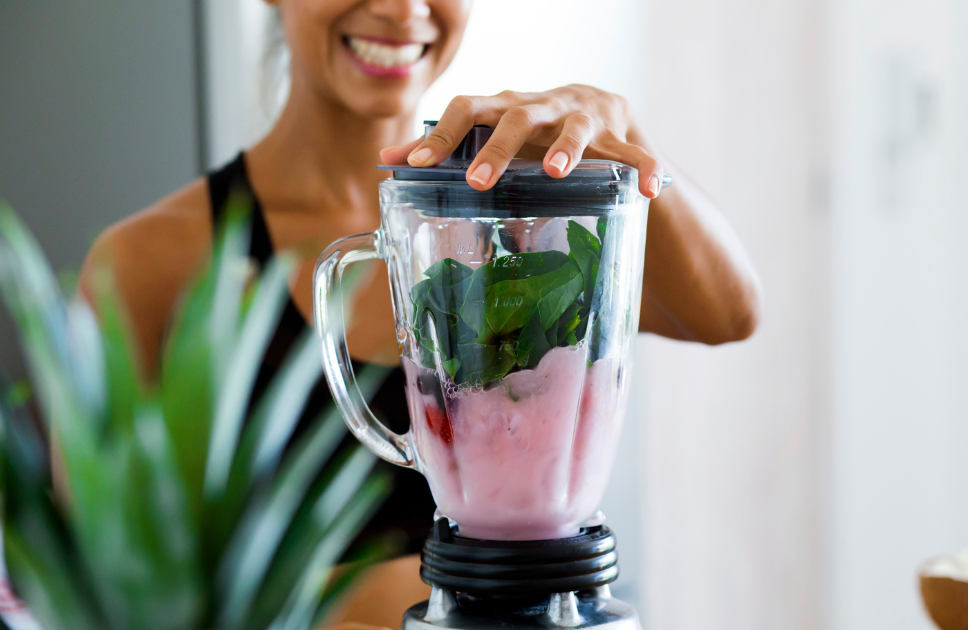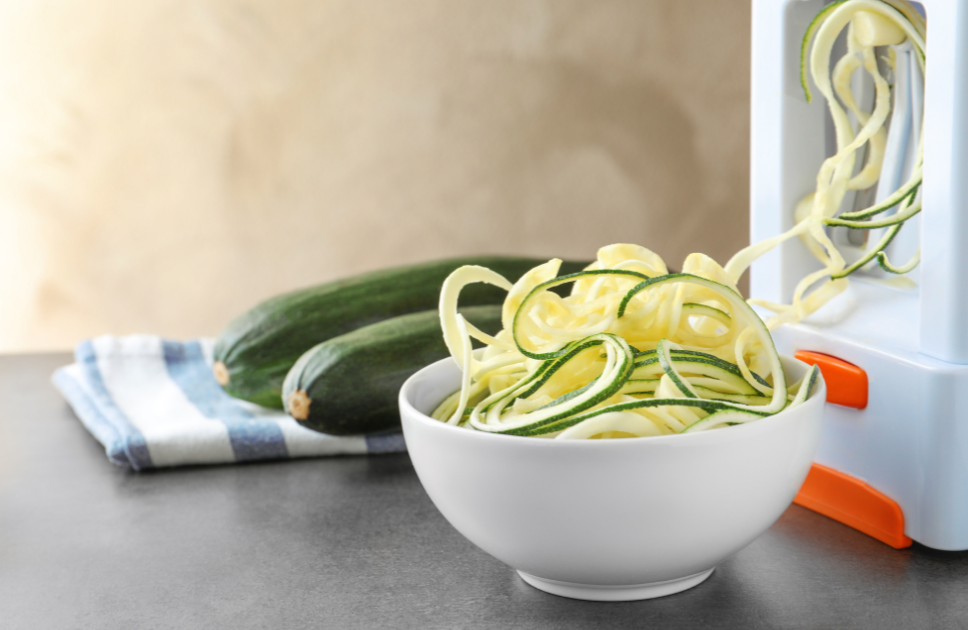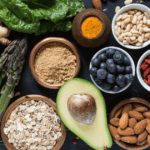If you’re like me, you plan your grocery trip with high intentions of eating your 5-6 servings of fruits and vegetables every single day. Then reality starts to set in mid-week, you get busy, and all of that once perfectly ripe produce is staring you in the face with its withering, rotting blight. Sigh. Maybe you’ll do better next week.
Don’t feel bad. We’ve all been there. Eating that many darn veggies every single day is hard. So here are 10 easy ways to incorporate them into your diet to increase your intake. Number 10 is my favorite and easiest way!
Why is Eating Vegetables Important?
Eating vegetables is one of the best things we can do for our health. They’re packed with essential vitamins, minerals, and phytonutrients that nourish the body and help prevent chronic diseases. Filling up on veggies can also help get rid of belly fat, which can tend to be stubborn especially after age 40.
We’ve all heard the advice to “eat the rainbow”. And that’s because different colored vegetables contain different nutrients.
Red and orange vegetables are high in vitamins A & C, which are important for vision, immunity, and fighting free radicals.
Dark green veggies, like spinach and kale, are high in iron which is important for red blood cell formation and hemoglobin function.
Blue and purple vegetables, like eggplant and purple cabbage, contain anthocycyanins which have antidiabetic, anticancer, and anti-inflammatory properties. They also help prevent cardiovascular disease.
White vegetables, like cauliflower, onions, and white mushrooms, contain nutrients that are known to reduce bad cholesterol as well as lower blood pressure.
So knowing the rainbow is one thing. Actually eating enough of it is another. Let’s look at how many servings of vegetables we should be getting each day and explore easy ways to incorporate more of them without eating salad at every meal.
How Many Servings of Vegetables per Day are Recommended?
Eating enough vegetables each day is essential for good health. The recommended amount of vegetables is 2 to 3 cups per day or 10 to 21 cups per week. This should include a good mix of the different color categories outlined above. In addition to vegetables, you should also aim to get 1 ½ to 2 cups of fruit per day.
To make it easier to get your daily servings of veggies, consider joining a CSA or having a box of fresh produce delivered to your door every week. Additionally, you can store your veggies on the top shelf of the fridge so they are always in sight and easy to grab when you need them. Preparing a whole week’s worth of vegetables over the weekend can also help save time during the week.
But if you still struggle, try some of these tips on how to eat more vegetables.
How to Eat More Vegetables:
1. Include Them in Your Smoothies
Adding vegetables to a smoothie is an easy way to get more nutrients into your diet. Fruits like bananas or frozen pineapple can help mask the flavor of vegetables in a smoothie, making it easier for kids and adults alike to enjoy. A 2021 study found that preschool kids enjoyed their smoothies with leafy greens, despite their green appearance.
Common vegetables added to smoothies include leafy greens such as spinach, kale, or Swiss chard. You can also add zucchini which creates a smooth texture without sacrificing flavor. Adding spinach to berry smoothies is an easy way to get an extra serving of greens without compromising on taste. You can also experiment with other vegetables like carrots, beets, celery, and cucumber for a nutritious boost. With the right combination of fruits and veggies, you can create delicious smoothies that are both healthy and enjoyable!

2. Add Pureed Vegetables to Sauces and Casseroles
When my kids were little, they loved mac ‘n cheese. One day I decided to add a jar of baby food carrots to it to add more nutritional value. I had to chuckle at their response, “Mmmm, yummy. What kind of mac ‘n cheese is this, Mom? It’s so good!”
That set me off on an adventure to add pureed vegetables to all kinds of dishes. I can’t say all were as successful (I don’t recommend adding baby food spinach to spaghetti sauce), but there are ways to include veggies in many sauces or casseroles without sacrificing flavor.
You could add fresh spinach to pesto or try pureed butternut squash in a cheesy dish. You could also start your spaghetti sauce with a mirepoix, a combination of diced onion, carrot, and celery.
If you like cheese, you’ll hardly notice the broccoli in a cheesy broccoli rice casserole. If you’re a fan of Mexican food, you could make a taco casserole and include diced jalapeño or red bell peppers. The possibilities are endless, and it can be fun to experiment!
3. Add Them to Your Sandwiches or Wraps
Adding vegetables to a sandwich or wrap is an easy way to get more nutrition into your diet. Not only are they packed with vitamins and minerals, but they also add flavor and texture.
It seems like it hardly counts as having veggies if you include lettuce and tomato on your sandwich, but every little bit you get absolutely counts towards your daily amount. Try adding fresh spinach instead of lettuce or adding cucumber in addition to your other toppings. Or add roasted red bell peppers for a tasty twist on your smoked turkey wrap.
4. Set Out a Snack Tray
You’d be surprised how many veggies will get eaten at your house if you set out a veggie tray. When my 3 kids were little, I put out a “snack tray” every day for noshing between meals. It would include things like cut-up carrots, bits of cauliflower, raw zucchini sticks, halved strawberries, dried cranberries, olives, cheerios, and other healthy snacks. I didn’t mind if they filled up on these and they all grew up to love a variety of fruits and vegetables. (Read here for gluten-free snack ideas to add to your snack tray.)
If you think about it, one of the biggest downfalls of our snacking is we’ll reach for whatever is handy. Getting veggies out of the fridge, washing them, and cutting them up when you’re hungry is not handy. But if you prep them in advance and set them out, you’ll be much more likely to reach for them when your hunger sets in.
5. Juice Your Vegetables
Juicing your vegetables isn’t as healthy as eating them because you give up a lot of the fiber. However, consuming juiced vegetables to meet your daily amount vs. not meeting your daily amount is a good idea.
Kale, carrots, spinach, and cucumbers are popular choices when it comes to juicing. They’re versatile and you can mix in fruits like apples, pineapples, or oranges to sweeten them. They’re also convenient if you find yourself too busy to sit down and eat a serving of vegetables.
6. Throw Some into Your Soup
Soups and stews are a great way to incorporate a variety of vegetables into your diet. Adding pureed vegetables is an easy way to sneak in extra nutrition without sacrificing flavor. Classic chicken soup can be enhanced by adding pureed vegetables such as tomatoes, squash, or potatoes. This will not only enhance the flavor but also thicken the soup.
Vegetables can also be diced up and added to broth- or cream-based soups for added texture and flavor. For a more unique flair, vegetables can be pureed with liquid and spices to form the base of the soup. This is an excellent way to get creative with your cooking while still providing a nutritious meal.
No matter what type of soup you’re making, incorporating vegetables is key for creating a healthy dish that’s packed with nutrients. Whether you choose to dice them up or puree them, adding vegetables will give your soup an extra boost of vitamins and minerals.
7. Make Vegetable Rice or Noodles
Vegetable rice or noodles are a popular alternative to traditional grains and can be used as a substitute for rice or pasta. Cauliflower and broccoli can be used as a substitute for rice, while carrots, zucchini, and sweet potatoes can be spiralized into noodles.
Try making cilantro-lime cauliflower rice for your next burrito bowl. Or tossing spiralized zucchini noodles with butter, salt, and pepper.
Spaghetti squash is an easy option that doesn’t require any spiralizing tools – just bake it cut side down until it softens and browns on the outside, then scrape out the inside with a fork to create spaghetti-like strands. You can serve this simply with butter, salt, and pepper or ladle your favorite marinara on top then sprinkle with parmesan cheese.

8. Eat Them with a Tasty Dip
The motto in our house is everything is better with a dip. You can buy a premade dip, like hummus or ranch, or make one on your own.
If you have extra free time, a homemade baba ganoush is sooo tasty! Or try pureeing cannellini beans with fresh garlic, kalamata olives, salt, and olive oil for a delicious, protein-packed dip.
9. Whip Up a Veggie Omelet
Omelets are a great way to add vegetables into your meal plan. Try adding spinach, onions, mushrooms, and tomatoes. I like to cook my veggies in a little oil or butter before folding them into my omelet. Add cheese (or dairy-free cheese if you’re sensitive to lactose) and you have a healthy, appetizing breakfast that you can whip up in minutes.
10. Take a Supplement Made from Real Vegetables
Ideally, you’d get all of your daily recommended veggies and fruits from your diet. However, many of us don’t meet that ideal. I take a daily Juice Plus+ supplement to bridge the gap between what I should eat and what I do eat.
They’re different from vitamins in that they’re made from whole food, plant-based, minimally processed ingredients. They contain 30 different real fruits, vegetables, and berries so their vitamins and antioxidants are bioavailable, making them easily absorbed by our bodies. A few of the ingredients in Juice Plus+ are spinach, kale, broccoli, carrots, beets, apples, and oranges (among others). They’re also vegan, gluten-free, and non-GMO.
Like juicing, they don’t contain all of the fiber you’d get if you ate all of those fruits and vegetables. But if you’re not getting all of your recommended servings through your diet alone, Juice Plus+ is a great and convenient way to fill in the gap. And for less than $2.70 a day, it’s just as nutritious (if not more) and cheaper than juicing.

Conclusion
Vegetables are a tremendous source of antioxidants, phytonutrients, and vitamins that nourish our bodies and keep us well. But many of us don’t meet our daily recommended requirements. Hopefully, you found a couple of ideas here that would work well for you to incorporate more vegetables into your diet. What are your favorite ways to get more veggies?




